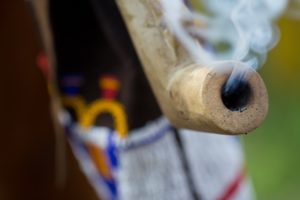
What is a “peace pipe”? When asked this question, some may conjure up mental images of Indigenous people from cartoons, old Western movies, and books who smoked these pipes with European settlers to seal a treaty. However, many of these depictions are fraught with inaccuracies and stereotypes. A basic understanding of sacred ceremonial pipes does not begin with American popular culture, but with a closer look at Native histories across the continent.
Why Were They Called “Peace Pipes”?
If you’ve ever heard or read the words “peace pipe,” you probably got the impression that one was smoked to finalize a treaty or an accord. You may also have been led to believe that it was a ceremonial object present in Indigenous groups across North America. While both ideas have some truth to them, the stories behind these instruments are much more complex.
Ceremonial pipes came to be known as “peace pipes” thanks to written accounts from early European settlers. One archived document in Marianopolis College’s “Quebec History Encyclopedia” contains a text published by the United States Bureau of American Ethnology in 1907. The unknown author noted that French explorers first applied the word “calumet” to this object. Interestingly, “calumet” is an old Norman French term, possibly descended from an old Greek word that means “reed” or “flute.” Even the Bureau of American Ethnology’s article concedes that ceremonial pipe design and construction varied from culture to culture, and that sealing treaties was only one of its many possible purposes. Yet thanks to multiple accounts of the pipes being used in this manner, the term “peace pipe” stuck.
One Type of Object, Many Different Names
Smoking pipes were used as ceremonial and ritual items in several Indigenous societies, most commonly those in the Plains, Eastern Woodlands, Pacific Northwest, Upper Midwest, and the Great Basin region that encompasses central California and Nevada. As a result, there are many different words for these same types of objects, for example, “chanupa” in Lakota or “calamat” in Umatilla. A short list of the cultures in which ceremonial pipes were used includes the following:
- Cherokee
- Creek
- Chickasaw
- Cheyenne
- Cree
- Lakota
- Mi’kmaq
- Nez Percé
- Potawatomi
- Winnebago
The Roles of Ceremonial Pipes in Native Cultures
As the Encyclopedia Britannica mentions, ceremonial pipes were usually filled with tobacco and smoked for a wide range of reasons. Besides sealing political treaties, they could be smoked to demonstrate agreement on business contracts. As each society constructed its own belief system and associated rituals, the religious use of pipes varied greatly. They were sometimes smoked as an accompaniment to prayers, not unlike how other cultures used incense to carry prayers to their deities. Other individuals also used them while seeking visions or spiritual guidance. In some cases, these pipes were carried through enemy territory or offered to hostile neighbors to signify peaceful intent. Finally, pipes were given as gifts to show goodwill.
A Few Notes on Pipe Making
Just as each society designated ceremonial pipes for its own purposes, pipes could also be constructed from a wide range of materials. Basic construction usually consisted of pairing a long, hollow wooden tube with a clay or stone bowl that held the tobacco. Both pipe and bowl are carefully cut, carved, and shaped, then polished to a fine finish and joined together. Pipes can come festooned with feathers, beadwork, fur, quills, or other adornments.
Like many artifacts from Indigenous societies all over North America, ceremonial pipes are both fascinating and misunderstood. Made for a wide range of purposes, these objects factored into the religious and social lives of many cultures. From treaty making to worship and prayer, these relics live on to tell tales from the past while their construction and use continues into modern times.

